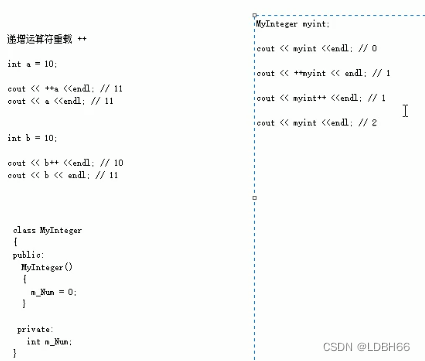运算符重载的概念:对已有的运算符重新进行定义,赋予其另一种功能,以适应不同的数据类型。
1.加号运算符重载
作用:实现两个自定义数据类型相加的运算。
例如:两个整型相加编译器知道该怎么进行运算,如果是两个自定义出来的类型,两个Person想加,编译器就不知道该怎么运算了。

#include<iostream>
#include<string>
using namespace std;
//加号运算符重载
class Person
{
public:
//1.成员函数重载+
/*Person operator+(Person& p)
{
Person temp;
temp.m_A = this->m_A + p.m_A;
temp.m_B = this->m_B + p.m_B;
return temp;
}*/
int m_A;
int m_B;
};
//2.全局函数重载+
Person operator+(Person& p1, Person& p2)
{
Person temp;
temp.m_A = p1.m_A + p2.m_A;
temp.m_B = p1.m_B + p2.m_B;
return temp;
}
//函数函数重载版本
Person operator+(Person& p1, int num)
{
Person temp;
temp.m_A = p1.m_A + num;
temp.m_B = p1.m_B + num;
return temp;
}
void test01()
{
Person p1;
p1.m_A = 10;
p1.m_B = 10;
Person p2;
p2.m_A = 10;
p2.m_B = 10;
//成员函数重载本质调用
//Person p3 = p1.operator+(p2);
//Person p3 = p1 + p2;//可以简化成这种形式
//全局函数重载的本质调用
//Person p3 = operator+(p1,p2);
//Person p3 = p1 + p2;//可以简化成这种形式
/*cout << p3.m_A << endl;
cout << p3.m_B << endl;*/
//运算符重载也可以发生函数重载
Person p3 = p1 + 10;
cout << p3.m_A << endl;
cout << p3.m_B << endl;
}
int main(void)
{
{
test01();
system("pause");
return 0;
}
总结:
- 对于内置的数据类型的表达式的运算符是不可能改变的//如int double,自定义的数据类型可以
- 不要滥用运算符重载
2.左移运算符重载
作用:可以输出自定义的类型
#include<iostream>
using namespace std;
class Person
{
friend ostream& operator<<(ostream& cout, Person& p);
public:
Person(int a, int b)
{
m_A = a;
m_B = b;
}
//利用成员函数重载左移运算符p.operator<<(cout)简化版本p<<cout
//一般我们不会利用成员函数来重载<<运算符,以为无法实现cout在左边
/*void operator<<(ostream &cout,Person &p)
{
cout << p.m_A << endl;
cout << p.m_B << endl;
}*/
private:
int m_A;
int m_B;
};
//只能利用全局函数来重载左移运算符
ostream& operator<<(ostream &cout, Person &p) //这样写的本质就是operator<<(cout,p)简化版本就是cout<<p;
{
cout << p.m_A << endl;
cout << p.m_B << endl;
return cout;//cout是ostream类型
}
void test()
{
Person p(10,10);
cout << p << "hello world" << endl;
}
int main(void)
{
test();
system("pause");
return 0;
}

3.递增运算符重载
作用:通过重载递增运算符,实现自己的整型数据。

#include<iostream>
using namespace std;
//重载递增运算符
class MyInteger
{
friend ostream& operator<<(ostream& cout, MyInteger myint);
public:
MyInteger()
{
m_Num = 0;
}
//重载++运算符——前置
//返回引用是为了一直对一个数据进行递增操作
MyInteger& operator++()//返回引用
{
++m_Num;
return *this;//this是指向自身
}
//重载++运算符——后置
//返回值不同不能作为函数重载的条件
MyInteger operator++(int)//这个int在这里作为占位参数,用来区分前置递增和后置递增
{
//先 记录当时结果
MyInteger temp = *this;
//后 递增
m_Num++;
//最后 返回
return temp;
//后置递增要返回值,因为如果返回引用,这里相当于返回的是一个局部对象的引用。
//局部对象在当前函数执行完毕之后就被释放掉了,还要返回引用就是非法操作。
}
private:
int m_Num;
};
//全局函数重载左移运算符
ostream& operator<<(ostream& cout, MyInteger myint)
{
cout << myint.m_Num << endl;
return cout;
}
void test()
{
MyInteger myint;
cout << ++(++myint);
cout <<myint;
}
void test02()
{
MyInteger myint;
cout << myint++ << endl;
cout << myint << endl;
}
int main(void)
{
//test();
test02();
system("pause");
return 0;
}
总结:前置递增返回引用,后置递增返回值。
4.赋值运算符重载
C++编译器至少给一个类添加4个函数(前三个之前已经讲过了)
- 默认构造函数(无参,函数体为空)
- 默认析构函数(无参,函数体为空)
- 默认拷贝构造函数,对属性进行值拷贝
- 赋值运算符operator=,对属性进行值拷贝
如果类中有属性指向堆区,做赋值操作时也会出现深浅拷贝问题。
#include<iostream>
using namespace std;
class Person
{
public:
Person(int age)
{
m_Age = new int(age);
}
~Person()
{
if (m_Age != NULL)
{
delete m_Age;
m_Age = NULL;
}
}
//重载赋值运算符
Person& operator=(Person &p)
{
//编译器默认提供的是浅拷贝操作//m_Age = p.m_Age;
//应该先判断是否有属性在堆区,如果有先释放干净,然后再深拷贝。
if (m_Age != NULL)
{
delete m_Age;
m_Age = NULL;
}
//深拷贝操作
m_Age = new int(*p.m_Age);
//指回自身的指针是this指针,返回对象本身
return *this;
}
int *m_Age;
};
void test1()
{
Person p1(18);
Person p2(20);
Person p3(30);
p3 = p2 = p1;
cout << *(p1.m_Age) << endl;
cout << *(p2.m_Age) << endl;
cout << *(p3.m_Age) << endl;
//三个人都是18
}
int main(void)
{
test1();
system("pause");
return 0;
}
5.关系运算符重载
作用:重载关系运算符,可以让两个自定义类型对象进行对比操作
#include<iostream>
#include<string>
using namespace std;
class Person
{
public:
//重载==
bool operator==(Person &p)
{
if (this->m_Name == p.m_Name && this->m_Age == p.m_Age)
{
return true;
}
else
return false;
}
bool operator!=(Person &p)
{
if (this->m_Name == p.m_Name && this->m_Age == p.m_Age)
{
return false;
}
else
return true;
}
Person(string name, int age)
{
m_Name = name;
m_Age = age;
}
string m_Name;
int m_Age;
};
void test()
{
Person p1("张三", 20);
Person p2("张三", 20);
if (p1 == p2)
{
cout << "p1和p2是相等的" << endl;
}
else
{
cout << "p1和p2是不相等的" << endl;
}
if (p1 != p2)
{
cout << "p1和p2是不相等的" << endl;
}
else
{
cout << "p1和p2是相等的" << endl;
}
}
int main(void)
{
test();
system("pause");
return 0;
}
//内置数据类型可以比对,但是自定义类型不行如:person这个数据类型
6.函数调用运算符重载
- 函数调用运算符()也可以重载
- 由于重载后使用的方式非常像函数的调用,因此称为仿函数
- 仿函数没有固定写法,非常灵活
#include<iostream>
#include<string>
using namespace std;
//函数调用运算符重载
class MyPrint
{
public:
//重载函数调用运算符
void operator()(string text)
{
cout << text << endl;
}
};
//仿函数非常灵活,没有固定的写法
//加法类
class MyAdd
{
public:
int operator()(int a, int b)
{
return a + b;
}
};
void test()
{
MyPrint myprint;
myprint("hello world");//这里myprint是上一行代码 MyPrint myprint;中的对象myprint
//()是重载的东西 //重载后使用的方式非常像函数的调用,因此称为仿函数
MyAdd myadd;
cout << myadd(1, 2) << endl;
//匿名函数对象 特点:当前行被执行完立即释放
cout << MyAdd()(100,100) << endl;
}
void test02()
{
MyAdd myadd;
int ret = myadd(100, 100);
cout <<"ret="<<ret<<endl;
}
int main(void)
{
test();
test02();
system("pause");
return 0;
}






















 1228
1228

 被折叠的 条评论
为什么被折叠?
被折叠的 条评论
为什么被折叠?








